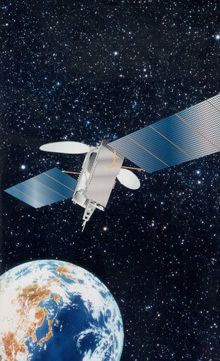Mission type Communication COSPAR ID 2000-060A Website JSAT Official Page Launch mass 3,531 kg Rocket Ariane 4 Manufacturer Lockheed Martin | Operator SKY Perfect JSAT Group SATCAT no. 26559 Launch mass 3,531 kg Launch date 6 October 2000 Bus Lockheed Martin A2100 | |
 | ||
Names N-SAT-110 (Nov 1998 onward) JCSAT-7 (Nov 1998 to Oct 2000) Superbird-5 (Nov 1998 to Oct 2000) JCSAT-110 (Oct 2000 onward)
Superbird-D (Oct 2000 onward) Similar JCSAT‑5A, JCSAT‑2A, Superbird‑C2, Superbird‑B2, JCSAT‑RA | ||
N-SAT-110, also known as JCSAT-7, JCSAT-110, Superbird-5 and Superbird-D, is a Japanese geostationary communications satellite which was operated by JSAT Corporation and Space Communications Corporation until both companies merged into SKY Perfect JSAT Group in 2008. It is positioned in geostationary orbit at a longitude of 110° East, from where it is used to provide communications services to Japan.
Contents
Satellite description
The spacecraft was designed and manufactured by Lockheed Martin on the A2100AX satellite bus. It had a launch mass of 3,531 kg (7,785 lb) with a dry mass of 1,669 kilograms (3,680 lb) and a 15 year design life. As most satellites based on the A2100 platform, it uses a 460 N (100 lbf) LEROS-1C LAE for orbit raising.
When stowed for launch, the satellite was 6 m (20 ft) high. Its dual wing solar panels gave a power generation capability of 8.3 kW at the end of its design life, with a span of 26.4 m (87 ft) when deployed. With antennas deployed, its width was 8.3 m (27 ft).
Its payload is composed of twenty-four 36MHz Ku band transponders with a TWTA output power of 120 Watts per channel. With its total bandwidth of 864 GHz it is used primarily for multi-channel pay per view business.
History
By September 1997, both JCSAT and Space Communications Corporation (SCC) had requested the 110°East position. The Japanese government made both companies share the 110°E position, and thus both made a joint order on November 20, 1998 for N-SAT-110 from Lockheed Martin. JCSAT used the JCSAT-7 designation for this satellite, while SCC used Superbird-5.
On October 6, 2000 at 23:01 UTC, an Ariane-42L successfully launched N-SAT-110 to a geostationary transfer orbit from Guiana Space Centre ELA-2. One hour later, at 00:04 UTC, October 7, the first signals from the satellite were successfully received from the Australia ground station. On October 14, 2000, at around 03:00 UTC, N-SAT-110 reached the geostationary orbit. Once it was put in orbit it was renamed as JCSAT-110 by JCSAT and Superbird-D by SCC.
During 2008, JSAT Corporation and Space Communications Corporation merged into SKY Perfect JSAT Group.
